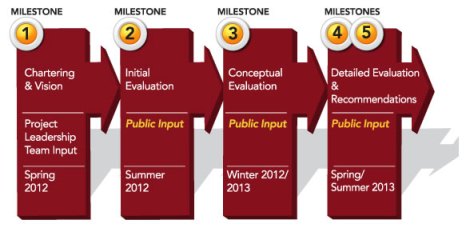Process
Process Overview
Previous studies concluded that high speed rail is potentially feasible on the I-70 and I-25 corridors, but did not make any final recommendations for implementation. The ICS will build on these previous studies to learn more details about alignments, station locations, and technology options.
Two outcomes can occur as a result of the ICS. The first would be that the study determines that high speed rail, though previously thought feasible, ends up being not feasible after the details are evaluated. The second would result in a recommendation for a specific future high speed rail project, including a ‘purpose and needs’ statement to define what the project would achieve and why. These steps do not move so far as to include an EIS, design plans, or funding options.
Purpose & Needs
The purpose of exploring high speed rail is to:
- Provide Colorado with a well-supported option for transportation that connects communities and destinations for interregional business and tourism travel
- Build on and strengthens Colorado’s existing transportation infrastructure
- Support the state’s vision as articulated in the state rail plan
- Determine whether the state-wide social, environmental, and economic benefits outweigh the costs of implementing high speed rail.
The ICS is needed to present potential solutions to the following needs:
- Address the mobility demands of future population growth.
- Improve mobility and system capacity through provision of an additional travel option.
- Enhance economic growth and development through improved connectivity.
- Improve the State’s environmental quality and energy efficiency.
- Provide economic benefits sufficient to receive new funding sources.
Milestone By Milestone
The study process has been developed to achieve broad goals while seeking stakeholder input at each major step.

Details for each milestone is listed below.
Milestone 1
Chartering & Vision – In May 2012, the study kicked off by engaging with each of the local cities, counties, metropolitan planning organizations, and regulatory agency stakeholders to get their support for the study vision, evaluation process, and public outreach strategies.
Milestone 2
Initial Evaluation – In June and July 2012, the study team examined multiple potential alignments (paths the high speed rail may follow) from previous studies and presented these to stakeholders for their input and direction. Public open houses were conducted in Colorado Springs, Pueblo, Fort Collins area, and the Denver area from July 16 to 19. The stakeholder feedback is being incorporated into the evaluation.
Click here to access the Level 1 Evaluation Report and Appendices.
Milestone 3
Conceptual Evaluation – The conceptual evaluation takes the information learned through the initial evaluation and further narrows the alignment options to the most promising based on the evaluation criteria. The study team will be working with stakeholders to identify potential station locations and to fully understand the potential benefits/impacts of the conceptual evaluation alternatives. Results of the conceptual evaluation are anticipated to be shared with stakeholders for input in winter 2012/2013.
The Study Team recently completed the Level 2 Evaluation Report. Information in this report will be used as a basis for the Level 3 Evaluation and will be integrated into the final report. Click here to access the Level 2 Evaluation Report and Appendices.
Milestones 4 & 5
Detailed Evaluation & Recommendations – Milestones 4 & 5 are grouped together. They build off of the public input received to that point and add additional engineering refinements to alignment options. A series of recommendations will likely surface for consideration by stakeholders and CDOT. Information and input gathered during the previous milestones and through the evaluation process have been integrated into the Draft Report. Click here to access the Draft Interregional Connectivity Study report.
